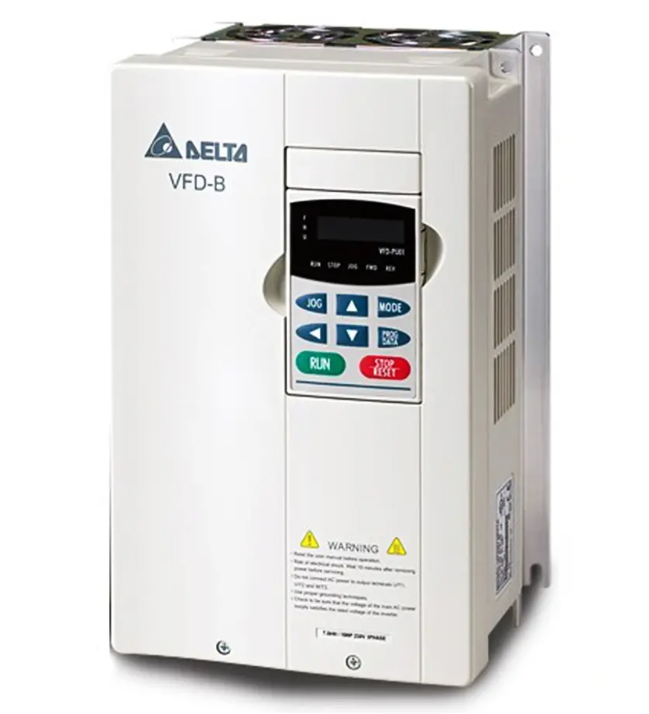El principio de funcionamiento del inversor Delta.
Sep 26, 2024
Introducción de la marca Delta Grupo es actualmente el fabricante líder mundial de productos de suministro de energía conmutada y ocupa una posición de liderazgo de clase mundial en múltiples áreas de productos, incluido el suministro de soluciones integrales para administración de energía, pantallas de video, automatización industrial, productos de comunicación de red y productos relacionados con energía renovable.Principio de ahorro de energía1. Ahorro de energía de frecuencia variableEl ahorro energético de los convertidores de frecuencia se manifiesta principalmente en la aplicación de ventiladores y bombas de agua. Para garantizar la confiabilidad de la producción, varias máquinas de producción se diseñan con una cierta cantidad de excedente cuando están equipadas con accionamientos eléctricos. Cuando el motor no puede funcionar a plena carga, además de cumplir con los requisitos de potencia del accionamiento, el exceso de par aumenta el consumo de potencia activa, lo que resulta en un desperdicio de energía eléctrica. El método tradicional de regulación de velocidad para equipos como ventiladores y bombas es ajustar el volumen de suministro de aire y agua ajustando la apertura de los deflectores y válvulas de entrada o salida. La potencia de entrada es alta y se consume una gran cantidad de energía en el proceso de interceptación de los deflectores y válvulas. Cuando se utiliza regulación de velocidad de frecuencia variable, si se reduce el requisito de caudal, el requisito se puede cumplir reduciendo la velocidad de la bomba o el ventilador.Según la mecánica de fluidos, P (potencia) = Q (caudal) × H (presión), el caudal Q es proporcional a la potencia de la velocidad de rotación N, la presión H es proporcional al cuadrado de la velocidad de rotación N, y la potencia P es proporcional al cubo de la velocidad de rotación N. Si la eficiencia de la bomba de agua es constante, cuando el caudal requerido disminuye, la velocidad de rotación N puede disminuir proporcionalmente y, en este momento, la potencia de salida del eje P disminuye en una relación cúbica. El consumo de energía del motor de la bomba de agua es aproximadamente proporcional a la velocidad de rotación. Cuando el caudal requerido Q disminuye, la frecuencia de salida del convertidor de frecuencia se puede ajustar para reducir proporcionalmente la velocidad del motor n. En este punto, la potencia P del motor eléctrico disminuirá significativamente según una relación cúbica, ahorrando entre un 40% y un 50% de energía en comparación con el ajuste de deflectores y válvulas, logrando así el objetivo de conservación de energía.Por ejemplo, un motor de bomba centrífuga con una potencia de 55 kW consume 28,16 kW de electricidad y ahorra un 48,8% de electricidad cuando la velocidad cae a 4/5 de la velocidad original. Cuando la velocidad cae a la mitad de la velocidad original, el consumo de energía es de 6,875 kW, lo que ahorra un 87,5% de electricidad.2. Compensación del factor de potencia para ahorrar energía.La potencia reactiva no sólo aumenta las pérdidas en la línea y el calentamiento de los equipos, sino que, lo que es más importante, la disminución del factor de potencia conduce a una reducción de la potencia activa en la red eléctrica. En las líneas se consume una gran cantidad de energía reactiva, lo que da lugar a una baja eficiencia del equipo y a graves residuos. Después de utilizar un dispositivo de regulación de velocidad de frecuencia variable, el efecto del condensador de filtrado interno del convertidor de frecuencia reduce la pérdida de potencia reactiva y aumenta la potencia activa de la red eléctrica.3. Arranque suave y ahorro de energía.El arranque brusco de los motores causa un impacto grave en la red eléctrica y también exige una capacidad excesiva de la red. La alta corriente y vibración generadas durante el arranque pueden causar daños importantes a los deflectores y válvulas, lo que es extremadamente perjudicial para la vida útil de los equipos y tuberías. Después de usar el dispositivo de ahorro de energía de conversión de frecuencia, la función de arranque suave del convertidor de frecuencia iniciará la corriente de arranque desde cero y el valor máximo no excederá la corriente nominal, lo que reduce el impacto en la red eléctrica y los requisitos de suministro de energía. capacidad y extender la vida útil de equipos y válvulas. Ahorro en costos de mantenimiento de equipos.Entorno de uso1. La temperatura ambiente oscila entre -10 ℃ y +40 ℃. Al quitar la etiqueta antipolvo en el extremo superior, se puede usar para temperaturas que oscilan entre -10 ℃ y +50 ℃2. Evitar que gotee agua de lluvia o ambientes húmedos3. Evite la exposición directa a la luz solar4. Prevenir la neblina de aceite y la erosión salina.5. Prevenir líquidos y gases corrosivos.6. Evite la entrada de polvo, algodón y virutas de metal.7. Manténgase alejado de materiales radiactivos e inflamables.8. Prevenir interferencias electromagnéticas (máquina de soldar, máquina eléctrica)9. Instalar lejos de cualquier equipo de calefacción.10. Evitar vibraciones (punzonadora). Si es inevitable, instale almohadillas amortiguadoras para reducir la vibración.11. Al instalar varios convertidores de frecuencia en el panel de control, preste atención a su ubicación para la disipación del calor. Además, instale un ventilador de refrigeración para mantener la temperatura alrededor de los convertidores de frecuencia por debajo de 50 ℃.12. Avance la parte frontal del convertidor de frecuencia y mantenga la parte superior hacia arriba durante la instalación para facilitar la disipación del calor.13. El espacio de instalación debe cumplir con las siguientes regulaciones: Si se instala dentro del disco o en el entorno circundante, la cubierta antipolvo del inversor se puede quitar para facilitar la disipación de calor y la ventilación del inversor.



